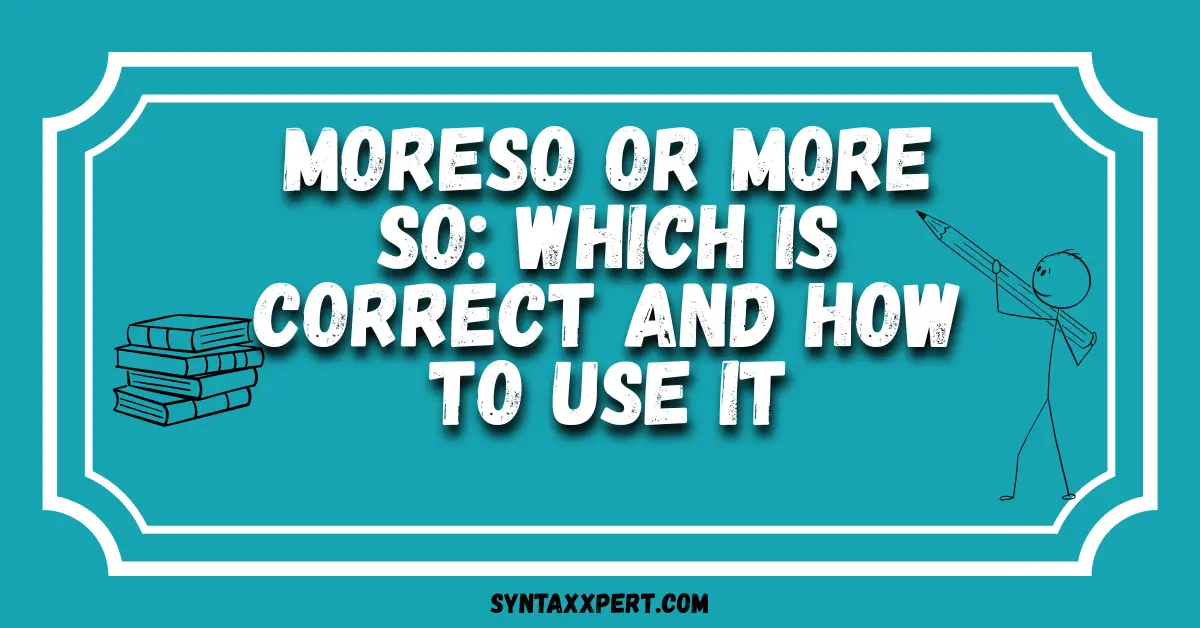When it comes to English grammar, few phrases cause as much quiet confusion as moreso or more so. You’ve probably seen both versions floating around the internet — in blog posts, social media captions, and even academic essays. But which one is grammatically correct? And why does the other even exist?
Let’s explore the difference between moreso and more so, how to use them, and why understanding the correct form can make your writing sound more polished and professional.
Understanding the Confusion Between “Moreso” and “More So”
At first glance, moreso and more so might seem identical. They’re pronounced the same and often appear in similar contexts — so it’s easy to see why people mix them up.
The confusion mainly arises because “moreso” looks like a natural compound, much like anymore or nonetheless. However, moreso isn’t officially recognized in most dictionaries, while “more so” is.
In modern digital writing, “moreso” has become increasingly common, appearing in tweets, comments, and informal blogs. But frequency doesn’t always equal correctness — and grammar experts agree there’s a clear winner here.
“Language evolves, but correctness still depends on structure and clarity.” — GrammarPaths Editorial Team
What Does “More So” Mean in English Grammar?
“More so” is the standard, grammatically correct phrase. It means to a greater degree or to a higher extent. It’s used to compare two things or ideas when “so” refers back to an earlier statement.
Here’s how it works:
| Example Sentence | Meaning |
| She was kind, but her sister was more so. | Her sister was even kinder. |
| He admired her skill, and his team did more so. | His team admired her skill even more. |
In these examples, “so” acts as an anaphoric adverb — it refers back to a quality already mentioned (“kind,” “admired”). That’s why “more so” makes grammatical sense, while “moreso” does not.
Is “Moreso” a Real Word?
Short answer: No — not officially.
“Moreso” isn’t recognized by major dictionaries like Merriam-Webster or Oxford English Dictionary. Some sources list it as a nonstandard or informal variant, but it’s still considered incorrect in formal English.
- Earliest use: Around the mid-20th century (informal American English)
- Modern perception: Acceptable in casual online communication, but not in academic, journalistic, or business writing
“Although ‘moreso’ appears in modern writing, style guides still recommend the two-word form ‘more so.’” — Chicago Manual of Style
Moreso vs More So — Side-by-Side Comparison
Here’s a quick look at how they differ:
| Feature | More So | Moreso |
| Type | Standard English phrase | Nonstandard spelling |
| Meaning | To a greater degree / extent | Same, but informal |
| Formality | ✅ Suitable for formal and academic use | ⚠️ Informal only |
| Dictionary Status | Recognized | Rare / unofficial |
| Correctness | ✅ Grammatically correct | ❌ Incorrect (informal use only) |
So, if you’re ever unsure — use “more so.” It’s universally accepted and fits every context.
When to Use “More So” vs “Moreso”
Here’s a simple rule of thumb:
- ✅ Use “more so” in formal, academic, or professional writing.
- ⚠️ Use “moreso” only in informal or conversational contexts — like social media, fiction, or dialogue.
For example:
- Formal: Her argument was strong, and his was more so.
- Informal: That movie was good, but the sequel? Moreso!
Even then, professional editors often recommend avoiding “moreso” entirely to maintain credibility.
Grammar Mechanics — How “So” Functions in Sentences
Let’s dive a little deeper.
In English grammar, “so” is often used as an anaphoric substitute — meaning it stands in for an adjective or phrase already mentioned. For instance:
- He was tired, and she was even more so.
Here, “so” replaces tired. That’s why “moreso” doesn’t work — it combines two separate grammatical elements (“more” + “so”) into one unrecognized structure.
In other words, “moreso” ignores grammatical logic.
Common Mistakes to Avoid
Even advanced writers make mistakes with “more so.” Here are a few to watch for:
| Mistake | Why It’s Wrong | Correct Version |
| He was excited, more so than ever before. | Redundant “so” | He was more excited than ever before. |
| Her work was detailed, and mine was moreso. | “Moreso” is nonstandard | Her work was detailed, and mine was more so. |
| I liked it moreso because of the music. | Incorrect form | I liked it more so because of the music. |
Examples of “Moreso” and “More So” in Sentences
Here’s how the two appear in real writing contexts:
Correct (Formal):
- The first draft was good, but the revised version was more so.
- He was confident, and his mentor was even more so.
Incorrect (Informal):
- I agree with you, moreso after hearing the explanation.
- This version feels better, moreso than the previous one.
You can see how the two-word form flows more naturally and reads more clearly.
Read More >>> Demasculate or Emasculate: Which Word Is Actually Correct?
Alternatives to “More So”
If you want to avoid overusing “more so,” try these alternatives:
- “Even more”
- “To a greater degree”
- “Especially”
- “All the more”
- “To a larger extent”
Example: Instead of “She enjoyed the meal, more so the dessert,” try “She enjoyed the meal — especially the dessert.”
Expert and Style-Guide Recommendations
Here’s what leading grammar authorities say about the two forms:
| Source | Verdict on “Moreso” | Verdict on “More So” |
| Merriam-Webster | ❌ Nonstandard / rare | ✅ Correct and common |
| Grammarly | ⚠️ Informal use only | ✅ Recommended |
| Chicago Manual of Style | ❌ Not acceptable in formal writing | ✅ Preferred |
| Grammarist | ❌ Nonstandard variant | ✅ Correct form |
| Oxford English Dictionary | ⚠️ Obsolete / informal | ✅ Recognized |
So, the expert consensus is clear — “more so” wins every time.
Why People Search “Moreso or More So”
Search data shows thousands of monthly queries for “moreso or more so,” reflecting how common this confusion is.
Interestingly, Google Trends reveals that searches for “moreso” have increased over the past few years, especially in North America. This rise might be due to casual writing habits in digital communication — similar to how words like “alot” or “irregardless” pop up online.
Still, in formal English, the traditional form remains the standard.
Quick Reference Summary
| Aspect | More So | Moreso |
| Meaning | To a greater extent | Informal variant |
| Acceptable in formal writing | ✅ Yes | ❌ No |
| Dictionary-listed | ✅ Yes | ⚠️ Rarely |
| Grammar correctness | ✅ Correct | ❌ Incorrect |
| Recommended for SEO content | ✅ Yes | ❌ Avoid |
FAQs
Is “moreso” a real word?
Not officially — it’s informal and not listed as standard in most dictionaries.
Is “more so” grammatically correct?
Yes, it’s the accepted and correct form.
Can I use “moreso” in essays?
No. Always use “more so” in formal or academic writing.
What does “all the more so” mean?
It intensifies a comparison: “She was proud, all the more so because she earned it.”
Is “moreso” used in British English?
Rarely — it appears slightly more often in informal American writing.
Final Thoughts
If you remember one rule from this article, make it this: 👉 Always write “more so,” not “moreso.”
While moreso occasionally sneaks into casual conversation or online posts, it’s still nonstandard and can make your writing seem unpolished.
When in doubt, keep it two words. Your grammar (and readers) will thank you — more so than ever.
💡 Key Takeaway
Correct: more so
Incorrect: moreso Always use the standard form in professional or academic writing.

I’m Luna Hazel, a grammar expert here to help you master the art of clear, confident writing. Let’s make every word count!

